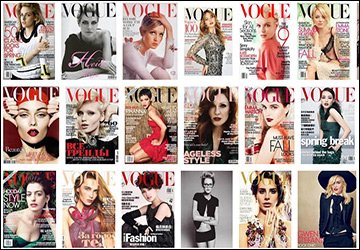Fashion world
Websites, blogs or glossy paper?
For years, there have been talks about the gloomy prospects of paper magazines, they are predicted to fade and completely disappear. Such conversations have been going on for a long time, but paper magazines are not going to disappear, but on the contrary, they are even multiplying.
Remembering the number of magazines 10-12 years ago, and the glossy editions of today, I see that today there are more of them. So the predictors are wrong and gloss will continue to flourish? Yes, print gloss and books will not completely disappear for many years to come.
Ordinary fiction books, educational literature, newspapers, their fate is a foregone conclusion, most of them will move to electronic format, and will be available to the consumer in free or paid versions. And magazines and books containing a large number of colorful illustrations that carry an entertainment and gift function can remain on paper for a long time.
Leafing through a large-format art album printed on high-quality paper is much more pleasant than looking at illustrations on the screen of a tablet computer. A large glossy magazine is also better, and therefore have a future if they offer quality material. Only glossy magazines have a serious problem with materials.

How much can you trust today's magazines and websites?
Most people subconsciously trust books and magazines more than Internet sites and blogs. There are good reasons for this - almost anyone can create and maintain a website or blog, and a whole team of professionals is needed to publish a magazine.
So in theory, but in practice, everything is much more complicated. In fact, creating a website or blog is very simple, but this does not mean at all that low-quality information will be published there. Blogs and sites are sometimes created and maintained by real professionals and people with all their hearts dedicated to their work. On the other hand, magazines can be published by a team of random people.
mystyle.decorexpro.com/en/ wanted to conduct an experiment and establish how much copyright articles are published in modern gloss. To do this, we selected several magazines and scanned the pages with the most interesting and voluminous publications. Then, using a text recognition program, they turned the scans into plain text and sent them to the Advego Plagiatus program. This program analyzes the text and finds copies of it on the Internet.
Finds not only full copies of the entire text, but also individual sentences, if they are repeated with 100% accuracy.
Having checked the glossy text, we found that it is often completely non-unique. Are sites copying gloss and rewriting their articles to themselves? A similar phenomenon takes place, but in this case everything was exactly the opposite. The magazine, positioned as a publication for professionals in the beauty industry, simply copied pieces of text from the Internet. The program clearly showed that the article was assembled from many fragments, each of which was copied one into one from different sites. The issue of the magazine was fresh, and pieces of the publication were on many sites and were included in the search engine index much earlier.
It is sad that the authors of gloss are too lazy to even write a publication in their own words, let alone feel the topic, experience it and share their experience.
The reader is eager to know which magazines do this? History is silent about this, since this publication is written not in condemnation and anti-advertising, but for reflection and a conscious choice. Today, there are many sources of information and it is very difficult to choose between them, so be careful - choose publications, subjecting their materials to a thorough check.
Comments and Reviews
Add a comment
Rating news
Shades of clothing that make women look younger
What shades of hair make women younger: rules and photos
Funny wedding dresses - photos and ideas
12 most expensive down jackets for the winter
How to look 25 at 40: tips from supermodels
Beautiful schoolgirls
Anti-aging haircuts and hairstyles for women
Fashionable skirts for autumn and winter
Fashionable women's trousers for the cold season
Fashionable and stylish sandals for summer 2024
Spring-summer 2024
 Fashionable dresses and tops with thin spaghetti straps
Fashionable dresses and tops with thin spaghetti straps
 Bandana tops: how to wear stylishly and beautifully
Bandana tops: how to wear stylishly and beautifully
 How to put together the perfect men's wardrobe for the summer
How to put together the perfect men's wardrobe for the summer
 Trendy shorts for spring-summer 2024
Trendy shorts for spring-summer 2024
 Fashionable skirts for spring-summer 2024: a guide to online shopping
Fashionable skirts for spring-summer 2024: a guide to online shopping
 The most fashionable dresses spring-summer 2024: styles and colors
The most fashionable dresses spring-summer 2024: styles and colors
 Fashionable total look 2024: image ideas and trends
Fashionable total look 2024: image ideas and trends





